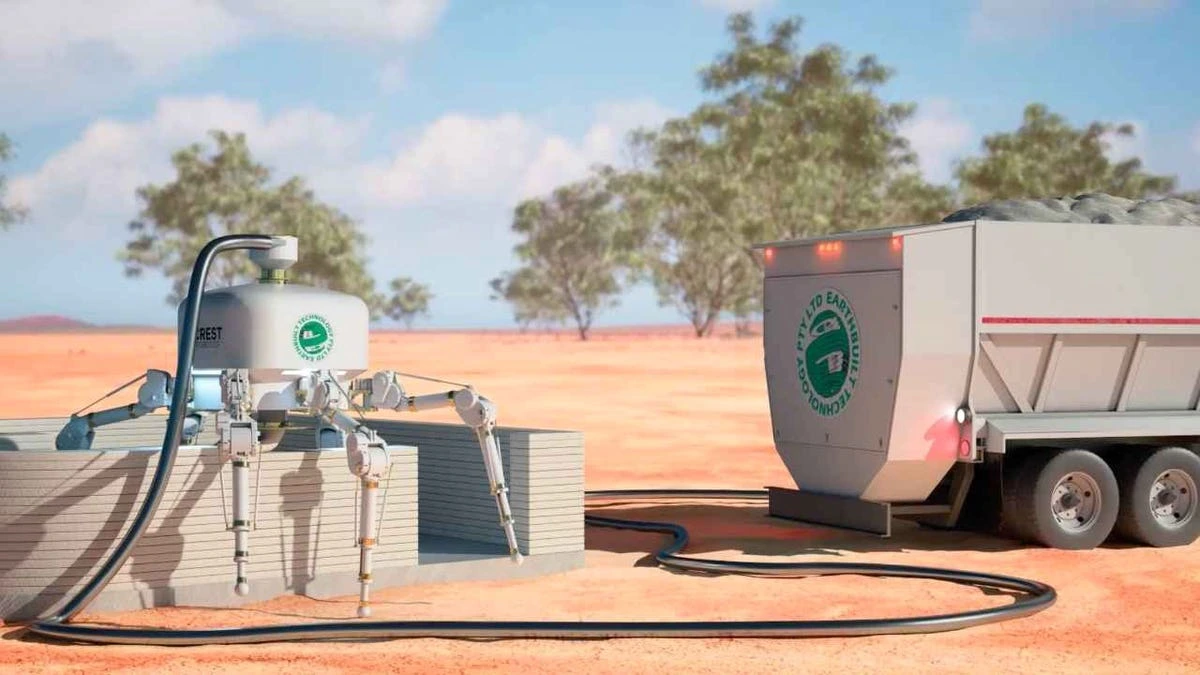SYDNEY — In a quiet suburb outside Brisbane, a spider like construction robot named Charlotte is turning heads and reshaping ideas about how homes are built. The Australian robot can 3D print an entire 2,150 square foot house in just one day, using locally sourced and sustainable materials.
Developed by Crest Robotics in collaboration with Earthbuilt Technology, Charlotte represents a major leap forward for the global construction industry.
Capable of working continuously without fatigue or error, the robot is part of a new generation of automated builders designed to meet rising housing demands while reducing environmental impact.
“This is not science fiction anymore,” said Dr. Olivia Barrett, chief engineer at Crest Robotics. “Charlotte demonstrates that large scale, sustainable construction can be automated, affordable, and environmentally responsible.”
For decades, construction has relied heavily on human labor, a sector plagued by delays, cost overruns, and safety hazards. Automation and robotics have long been proposed as solutions, but until recently, the technology wasn’t ready to handle the precision, materials, and scale required for residential projects.
Charlotte changes that equation. The robot uses a massive extrusion system to layer a mixture of sand, crushed brick, and recycled glass materials chosen for their durability and environmental benefits.
The result is a fireproof, flood resistant structure with a much smaller carbon footprint than traditional cement based construction.
Crest Robotics and Earthbuilt Technology, both based in Queensland, say the collaboration emerged from a shared goal to address Australia’s growing housing shortage with sustainable innovation.
Experts say the arrival of Charlotte could mark a turning point for both housing affordability and sustainability.
“Automation like this could cut construction times by up to 80 percent and material waste by nearly half,” said Professor Liam Turner, a civil engineering researcher at the University of Melbourne. “That’s a big deal for an industry that contributes almost 40 percent of global CO₂ emissions.”
Turner noted that while robots have been used in manufacturing for decades, their adoption in construction has lagged due to complex on site conditions and variable materials.
Charlotte’s flexible design, however, allows it to adapt to uneven terrain and build customized designs without additional tooling.
“The technology is modular, meaning it can scale from a small cottage to a multi story complex with minimal changes,” Barrett added. “That flexibility is what sets Charlotte apart.”
According to data from the Australian Construction Industry Forum, residential construction times in the country average between four to six months per home.
Charlotte’s one day completion rate represents a radical improvement in speed, equating to the productivity of more than one hundred skilled bricklayers working simultaneously.
The robot’s use of recycled materials also has measurable environmental benefits. A 2024 study by Earthbuilt Technology found that homes printed with Charlotte produce 65 percent fewer carbon emissions than conventional concrete structures.
Globally, similar 3D printing systems are emerging in the United States, China, and the Middle East, but Charlotte’s focus on sustainability and local material sourcing distinguishes it from many competitors.
“Where some 3D-printed homes rely on synthetic polymers or imported composites, Charlotte uses what’s already available around the build site,” said Turner. “That’s a circular economy approach and it’s exactly what the construction industry needs.”
On a test site in Queensland, construction workers and engineers watched as Charlotte’s robotic arms moved in rhythmic precision, extruding layer upon layer of the eco friendly mixture.
“It’s fascinating to see,” said Jason McNeil, a local builder who has worked in the industry for more than two decades. “At first, I was skeptical. But seeing a structure go up this fast, and knowing it’s sustainable it’s hard not to be impressed.”
Residents in nearby neighborhoods are also intrigued by the potential for more affordable housing.
“If this can make homes cheaper and faster without hurting the planet, I think people will embrace it,” said Grace Tan, a homeowner in Brisbane’s northern suburbs.
“It could really help younger families who can’t afford traditional builds.” Crest Robotics and Earthbuilt Technology have plans that reach beyond Australia’s shores.
The companies are in early discussions with international partners interested in adapting Charlotte for emergency housing, disaster recovery, and even extraterrestrial construction.
Dr. Barrett revealed that a future version of the robot could one day build research bases on the moon. “The same principles apply,” she said. “Charlotte is autonomous, efficient, and adaptable to harsh environments.
Whether it’s a desert in Western Australia or the lunar surface, the technology remains viable.” The idea of robotic builders working off Earth is gaining traction.
NASA and the European Space Agency have explored 3D printing as a way to construct habitats using lunar regolith, the fine dust that covers the moon’s surface. Charlotte’s design and material versatility make it a potential prototype for such missions.
“Automation is not about replacing people,” Barrett emphasized. “It’s about giving humanity the tools to build faster, safer, and smarter on this planet and beyond.”
As housing shortages and climate concerns intensify worldwide, Australia’s 3D printing robot Charlotte offers a tangible solution. By combining speed, sustainability, and local innovation, it demonstrates how automation can redefine one of humanity’s oldest industries.
While challenges remain including regulation, cost scaling, and public perception Charlotte stands as a milestone in robotic construction, bridging the gap between science fiction and real world sustainability.
In the words of Professor Turner “We’re witnessing the first chapter of a new construction era one where machines like Charlotte don’t just build homes, they help build a better future.”

